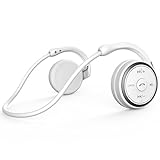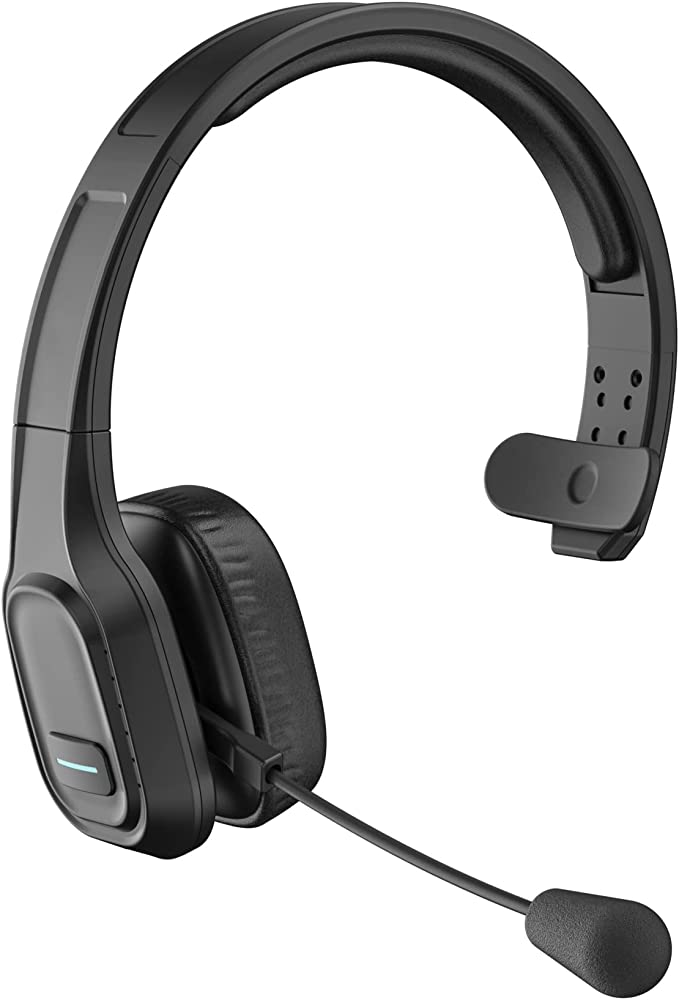For many of us who weave physical activity into the fabric of our lives, music isn’t just background noise; it’s a pacer, a motivator, a private sanctuary. Yet, the quest for the perfect audio companion for these active moments often feels like navigating a field of compromises. Do we choose the immersive sound that isolates us, perhaps dangerously, from the world around us? Do we endure the discomfort of ill-fitting earbuds for the sake of stability, or tolerate headphones that demand constant readjustment, breaking our rhythm and focus? And then there’s the ever-present specter of a dying battery, cutting short a well-earned endorphin rush. The RTUSIA Marathon Small Wireless Headphones step onto this stage, proposing a design philosophy edad at addressing these very conundrums. As an audio ergonomics and sports technology specialist, I’ve taken a keen interest in designs that prioritize not just sound, but the holistic experience of the active user. Let’s delve into what makes these particular headphones tick.

Freely Outside: The Ergonomic Science of Open-Ear Comfort
One of the most immediate challenges many active individuals face with personal audio is the sheer physical experience of wearing it. That persistent ache from pressure points within the ear canal, the awkward interference with glasses, or simply the feeling of being “plugged up” can turn a pleasant workout into an ordeal. The RTUSIA Marathon headphones approach this with a “wrap around head” architecture, where, critically, the earpieces “rest outside of your ears instead of within the ear canal.”
This supra-aural (on-ear, or more accurately, resting on the outer ear) design is a significant ergonomic choice. By avoiding direct insertion, it sidesteps the common issue of pressure buildup within the ear canal. Imagine the relief for those with sensitive ears; as one user, Morgan, aptly put it in her review of a blue pair, she found them excellent for her “sensitive ears,” adding that she “Would not getting ears sore like with earbuds.” This design also thoughtfully accommodates those who wear glasses. The product description notes, “Wearing these with glasses is still comfortable,” a small but crucial detail for many. It’s the difference between a seamless integration into your existing gear and a constant source of minor irritation.
Then there’s the matter of weight. At a listed 3.52 ounces, these headphones are engineered to be exceptionally lightweight. From a biomechanics perspective, any mass added to the head requires muscular effort to stabilize, especially during dynamic movements like running or jumping. Reducing this mass minimizes the inertial forces your neck and shoulders have to counteract. The goal, often achieved with such lightweight designs, is for the headphones to almost “disappear” perceptually, allowing you to focus entirely on your movement and music. The product description echoes this, stating, “The headphones are light enough that you don’t even notice them when go for a run.” Comfort, in this context, isn’t a mere luxury; it’s a cornerstone of an undistracted, enjoyable, and ultimately more effective workout.

Locked in Motion: The Biomechanics of a Stable Fit
Beyond comfort, if a pair of headphones can’t stay put during a vigorous workout, they’ve failed a primary test. The frustration of a dislodged earbud or a slipping headband is a universal experience for active audio users. The RTUSIA Marathon addresses this with its secure, wrap-around structure.
The physics of this stability lies in its multi-point contact and distributed design. Unlike earbuds that rely heavily on the friction within a small contact area of the ear canal, or simple headbands that might shift with head tilt, the wrap-around form of the Marathon presumably engages the back of the head and the top/back of the ears. This creates a more anchored system. Think of it like a well-fitted backpack that distributes its load and hugs your torso, versus a single-strap bag prone to swinging wildly. The product description highlights this advantage: “when you are on the treadmill, it stays in place so much better than earbuds.” This suggests a design that anticipates the G-forces and multi-directional movements inherent in many forms of exercise.
The practicality extends to its Foldable Factor. While designed for portability – “Can easily put them in the pocket,” as the description notes – the engineering of a reliable folding mechanism is also key. In general product design, hinges and moving parts are potential points of wear. A well-executed foldable design in sports headphones aims to offer this convenience without unduly compromising the structural integrity needed for daily active use. Users appreciate being able to stow their gear easily, and this feature makes the Marathon headphones a more practical companion for gym visits or travel.

The Aware Athlete: Navigating Your World with Open Acoustics
Perhaps one of the most critical considerations for outdoor athletes, or even those in bustling gym environments, is situational awareness. Traditional noise-isolating or noise-canceling headphones, while excellent for focused listening in controlled settings, can create a dangerous “bubble” when you need to be cognizant of your surroundings. The RTUSIA Marathon champions an open acoustic design.
What does this mean in practice? Imagine listening to your favorite playlist in a room with the windows open. You can enjoy the melodies clearly, yet you’re still connected to the sounds of the world outside – a passing car, a distant conversation, the chirping of birds. This is akin to the “open window effect” these headphones aim for. By not sealing the ear canal, they allow ambient sounds to naturally reach your ears. The product description is explicit: “You want to hear them [other people/bikes] approaching from the back.” From a psychoacoustic standpoint, our brains are wired to constantly process these environmental cues for safety. For a runner on a shared path, a cyclist navigating urban streets, or even someone in a busy park, hearing these cues is not just a convenience, it’s a vital layer of protection. User Eric B., in his review, specifically praises this aspect, noting it’s “important if you are jogging or around people in general.”
Now, one might wonder if an open design compromises sound clarity. The RTUSIA Marathon is described as delivering “Crystal-Clear Sound.” This is typically achieved in open-back or on-ear designs through careful acoustic engineering of the drivers (the tiny speakers in the headphones) and their housing. The goal is to direct the sound effectively towards your ear canal, providing a clear and intelligible personal audio experience, even if some external sound is also present. It’s about finding a balance. This clarity extends to calls; the product features “stereo calling,” and the description claims the quality “sounds like when you are holding a phone,” suggesting a focus on natural and clear voice transmission via the built-in microphone.
It’s worth noting that the provided “Product information” table confusingly lists “Active Noise Cancellation” under “Noise Control.” This directly contradicts the overwhelming product description, user feedback, and the inherent nature of an open, on-ear design that is meant to allow situational awareness. Based on the holistic information, the defining characteristic is indeed its openness, not noise cancellation.

Endurance for the Journey: Power and Intuitive Control
For any wireless device, especially one accompanying you on long runs or through multiple gym sessions, battery life and ease of control are paramount. A dead battery can deflate motivation, and fumbling with poorly designed controls is a surefire way to break your stride and concentration. The RTUSIA Marathon is equipped with a claimed 12-Hour Battery Life and a 4-button tactile control system.
Twelve hours of playback is a substantial duration. Underpinning this is typically a Lithium Polymer battery, a technology favored in portable electronics for its energy density and relatively light weight. In real-world terms, this endurance could mean, as the product description suggests from user experience, using them “several hours a day and charge it on Monday, the battery would last the whole week.” This significantly reduces “battery anxiety” and the hassle of frequent recharging. They even “arrived fully charged and ready to go out of the box.”
The control interface, located on the right earpiece, features four distinct buttons – “not two like in-ear ones” – for managing calls, volume, and track skipping. The ergonomic intelligence here lies in the tactile feedback; “Each button is indicated with a raised dot but if you take a minute to situate your finger on the dial it’s easy to navigate.” This is crucial for “eyes-free” operation. When your focus is on your run, your form, or the path ahead, you need to be able to adjust your audio by touch alone, relying on muscle memory rather than visual confirmation. While generally a user-friendly setup, user Morgan did note that having all controls on one side could be “a pain” for left-handed individuals or when the right hand is occupied.
Connectivity is, of course, handled by Bluetooth, the ubiquitous standard that grants these headphones their wireless freedom. While the specific version isn’t officially detailed, user Eric B. speculates it might be an older v4.2. Regardless of the version, the core benefit is the untethered experience. On the topic of connections, Eric B. also pointed out the use of a Micro USB port for charging, noting a preference for the more modern USB-C. This is an objective observation reflecting current technological trends, where USB-C offers benefits like reversible connectors and potentially faster charging protocols, though for a device with such long battery life, the charging frequency is lower.
The Sum of Its Parts: A Holistic Companion for the Active Soul
When we look at the RTUSIA Marathon headphones, it’s not just about individual specifications but how these elements synergize to serve the active user. The lightweight, external-ear design prioritizes sustained comfort. The wrap-around structure targets stability during vigorous motion. The open acoustics champion environmental awareness and safety. The extended battery life and tactile controls aim for uninterrupted and intuitive use. Even the foldable design speaks to the practical needs of an on-the-go lifestyle.
User feedback, like Eric B.’s mention of the material “repelling sweat” and the inclusion of “an additional set of ear pads for replacements,” further paints a picture of a product designed with the realities of exercise in mind. Of course, no design is without its trade-offs or areas for potential improvement, such as the aforementioned Micro USB port or the lack of an included carrying case, also noted by Eric B. These are practical considerations that users weigh.

Concluding Thoughts: Listening to Your Needs, Amplifying Your Life
The RTUSIA Marathon wireless headphones, as presented through their features and user experiences, appear to embody a thoughtful approach to a common set of challenges faced by active individuals. They strive to deliver a listening experience that is liberating rather than restrictive, comfortable rather than cumbersome, and aware rather than isolating.
Ultimately, the “best” audio gear is deeply personal, contingent on individual priorities, the types of activities pursued, and the environments frequented. However, by understanding the ergonomic principles, acoustic considerations, and technological underpinnings of a product like the RTUSIA Marathon, we empower ourselves to make more informed choices. It’s about selecting tools that don’t just play music, but genuinely enhance our engagement with our activities, our surroundings, and our overall well-being. The pursuit of an active life is a journey, and having the right companion, even one that just whispers encouragement or a driving beat in your ear, can make all the difference.




